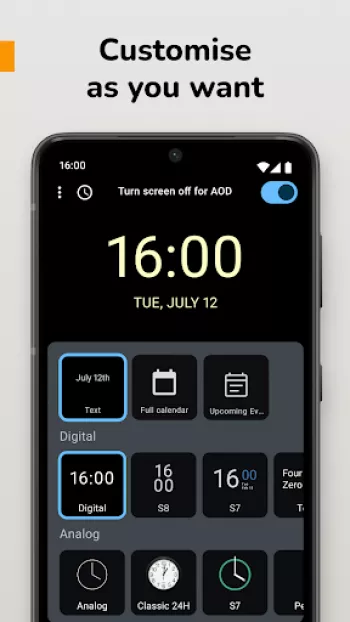Apps Home

The Evolution and Practical Utility of Always On Display Technology
Always On Display (AOD) technology has revolutionized the way users interact with their devices, bringing a blend of functionality and aesthetic appeal to the forefront of mobile interface design. This feature, which originated from the need to provide users with quick access to essential information without the need to unlock their devices, has seen significant evolution over the years. Initially introduced in simple monochrome forms, AOD technology has evolved into a sophisticated display option that incorporates colorful AMOLED screens and customizable interfaces, making it a staple in modern devices. Imagine a world where you can quickly check the time, notifications, or even control your music without having to engage with your device directly. The Always On Display feature allows this seamless interaction by leveraging low-energy components inherent in AMOLED screens. This capability is primarily due to the fact that AMOLED screens only light up the pixels required to display the necessary information, leaving the rest of the screen off, which reduces energy consumption. In practice, this means that users can have vital information at their fingertips, literally, as the screen provides real-time updates while conserving battery life. Beyond simple time display, AOD supports various functionalities such as displaying calendar events, weather updates, and a myriad of notification options. The real beauty, however, lies in its customization potential. Users can choose from a plethora of display clock styles, including digital, analog, or even graphical interpretations to suit personal preferences. The ability to personalize these options ensures that every user’s experience is uniquely tailored, enhancing the bond between the user and their device. This technology’s integration into operating systems like Android has allowed third-party apps, such as the one found on Google Play Store, to offer extended capabilities that surpass the native screen features. These apps often come with even more flexible customization options, such as themed wallpapers and various clock styles, ensuring that the AOD experience remains dynamic and engaging. Moreover, the ability to seamlessly integrate notifications and control music playback further showcases the practical utility of AOD, making it not just a static feature but an interactive part of the daily digital experience.
Technical Aspects and Configuration of Always On Display Features
From a technical standpoint, the Always On Display feature is a prime example of how modern devices utilize hardware efficiencies to enhance user experience while conserving resources. The core of this feature relies heavily on AMOLED display technology, which is distinct from traditional LCDs due to its ability to control pixel illumination individually. This means that only the pixels required to display certain information are activated, while the others remain off, contributing to power conservation. In configuring AOD, users are often given access to detailed settings that allow them to fine-tune what is displayed. This might include default options such as time and date or more advanced configurations like choosing which app notifications should be visible. Advanced settings might also allow users to enable features like 'Pocket Mode', which intelligently locks the screen when the ambient light sensor detects the device is stored away. Additionally, a feature like 'Auto Night Mode' adjusts the screen's brightness based on the surrounding environment, ensuring the display does not become a distraction in low-light settings. Developers have also integrated options such as 'Raise to Wake', which combines the device’s accelerometer capabilities with AOD, allowing the screen to activate when the device is lifted. This intuitive interaction can be particularly helpful for users on the go. Moreover, settings for reducing burn-in, a common problem associated with AMOLED screens, are crucial. Auto-moving display elements periodically help prevent damage to the screen, thereby extending the device’s lifespan. Many apps offer additional functionality by integrating services like Greenify to manage background processes directly from the AOD. Yet, configuring these technologies often requires users to grant specific permissions, such as modifying system settings or accessing the camera to toggle the flashlight. These permissions ensure that the Always On Display operates seamlessly while maintaining the integrity and security of the device's core functions.
Understanding Practical Customization and Use Cases
Customization is at the heart of the Always On Display feature, providing users with the ability to transform their screen into a canvas that reflects their personal and professional lives. The practical applications of such customization are vast and only limited by the imagination of the user. For instance, a business professional might prefer to have a quick view of their schedule or the latest emails, readily available with a mere glance at their screen. Customization enables them to prioritize the information that appears without needing to unlock their phone continually. On the other hand, a student might benefit from having quick notes or reminders flash periodically, utilizing the AOD feature to enhance productivity and organization. This functionality is often achieved by leveraging various AOD apps available, which allow for creating quick memos or integrating task management reminders directly into the lock screen display. Moreover, music lovers can use AOD to control playback, providing an intuitive interface that allows them to skip tracks or adjust volume right from the lock screen. This becomes particularly useful during activities like working out or commuting when fumbling with the phone is inconvenient. The aesthetic customization options include selecting from a wide array of backgrounds and styles, from minimalist designs to vibrant, dynamic wallpapers, which can align with seasonal themes or personal taste. Another intriguing use case includes setting up the device to offer contextual information such as the current temperature or forecasted weather, given at a glance to help decide on outfits or travel plans spontaneously. Integrating widgets that provide such real-time updates creates a seamless interaction between the user and their device, making the device not just a tool but a personal assistant. These extensive customization capabilities are supported by apps that further extend the device's innate options, empowering users to craft a display experience that complements their lifestyle and personal preferences while maintaining functionality.
Integration with Third-Party Applications and Advanced Features
Integration with third-party applications significantly enhances the versatility and functionality of the Always On Display feature, providing users with tools to tailor their experience beyond factory settings. Third-party apps available through platforms such as the Google Play Store offer extended customization and additional features that can transform how information is accessed and presented. These applications often provide innovative solutions for reducing screen burn-in, a common concern associated with static displays. By integrating automatic movement of on-screen elements, these apps minimize the risk of image retention. Additionally, third-party apps facilitate integration with popular services like Spotify for music control, Google Calendar for event reminders, and even productivity apps like Tasker, which allows for automation of everyday tasks directly from the AOD interface. Advanced users can utilize these integrations to set automatic rules that adjust display settings based on location or time of day, ensuring that the feature remains unobtrusive and efficient. For example, integration with weather services means that current climate conditions are visible at any time of day, providing useful data that factors into planning outings or commutes. Moreover, apps often come equipped with built-in green modes, partnering with applications like Greenify to manage battery usage more effectively by controlling background applications. The interconnectivity provided by these apps allows users to engage with a digital ecosystem that is coherent and personal. It's not just about displaying information but about making that information relevant and functional within the context of the user's day-to-day. This synergy between device and applications allows users to maximize the potential of Always On Display, making it not just a feature, but a dynamic element of daily life. The ability to link Tasker profiles, set custom watch faces, or even insert widgets from beloved applications enhances the practicality and enjoyment derived from the AOD experience, pushing the boundaries of what a typical lock screen can achieve.
Security, Permissions, and Future Developments in Display Technology
Security and permissions are paramount when discussing the Always On Display technology, as its integration requires access to several core components of a device’s operating system. For optimal performance, AOD applications often request permissions to modify system settings, control the camera, or manage phone permissions. Ensuring that these permissions are granted appropriately is crucial for maintaining both the functionality and security of the device. For instance, camera permissions might be necessary for toggling the flashlight, while phone permissions can allow the application to recognize and manage notifications from incoming calls. While these permissions enhance the utility of the AOD feature, it is vital for users to remain informed and cautious about the permissions they accept to prevent unauthorized access to sensitive information. As technology advances, the AOD feature is anticipated to evolve further, integrating with more advanced technologies such as AI for predictive information display and enhanced security protocols. For example, future iterations might include biometric integration, ensuring that personalized information appears only when recognized by the device owner. Moreover, as new display technologies emerge, such as MicroLED and advanced OLED variants, the potential for more energy-efficient and vibrant Always On Displays becomes increasingly viable. With the integration of AI and machine learning, future AOD setups might predict the most pertinent information a user might need based on contextual data, further streamlining the interaction between user and device. While the path forward is filled with potential, developers must balance innovation with privacy and security, ensuring that new features provide tangible value without compromising user trust. The future of Always On Display technology lies in embracing these cutting-edge advancements while maintaining a user-centric approach that safeguards information and enhances usability. Interested users can explore current AOD applications and potential updates for platforms like Android to experience firsthand these innovations and participate in shaping the future trajectory of display technology.
Share Your Opinion
Your Email Will Not Be Published.
All Rights Reserved © Apps Home 2025































Jacqueline White
This is the best app on my phone. I have time, weather, notifications on my phone 'off' screen 24/7. It sits on my desk, kitchen, bedroom and I loo...
Sophonie Bazile
I've been using the app for at least a couple of weeks and, so far, it's been working pretty well. My LG G8 ThinQ comes with a built-in AOD feature...
A Google user
Using this on a Xiaomi Redmi 5 Plus. This does exactly what I wanted it to do. I had to pay for the pro version to get the things I wanted, but t...
Damon Tellegen
had to revisit this app 6 years later it's pretty great so far and it's changed... I had to uninstall and reinstall. the color change (font) messed...
A Google user
I like that the app is smartly designed to move around enough to avoid burn-in (although I think it should move even more because some pixels remai...